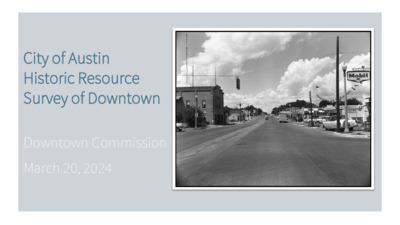Item 5 Historic Preservation Survey Presentation — original pdf
Backup

City of Austin Historic Resource Survey of Downtown Downtown Commission March 20, 2024 1. Survey Boundary 2. Project Schedule & Status 3. Scope and Methodology 4. Frequently Asked Questions 5. Opportunities for Input 6. Questions Survey Boundary Survey Boundary: Downtown Austin and Adjacent Neighborhoods - HHM will survey both parcels with CAD dates of 1979 or earlier and parcels with no known date - Excludes local historic districts and recently surveyed areas - Estimated maximum of 1,553 parcels Map illustrating the survey boundary and excluded areas. Project Schedule & Status Project Schedule Task Task 1. Project Initiation/Project Plan and Schedule Task 2a. Draft Fieldwork Methodology Task 2b. Final Fieldwork Methodology Task 3. Fieldwork and Community Coordination Task 4a. Draft Research Design Task 4b. Final Research Design Task 5. Research & Community Input Task 6. First Draft Survey Report and Contexts for City Task 7. Second Draft Survey Report and Contexts for Public Task 8. Final Survey Report and Contexts Deadline Friday, October 13, 2023 Friday, November 17, 2023 Friday, December 15, 2023 Friday, March 29, 2024 Friday, May 10, 2024 Friday, June 7, 2024 Friday, August 9, 2024 Friday, October 18, 2024 Monday, January 6, 2025 Friday, February 28, 2025 Survey Status: Downtown Austin and Adjacent Neighborhoods - 1,989 resources surveyed as of March 15, 2024 - City Directory research complete for all historic-age resources not previously designated - Occupant research underway - Evaluation of significance and potential eligibility underway Map illustrating survey completed to date as of March 15,2024 Scope and Methodology Survey Preparation and Prior Data Integration The GIS-based survey forms will be prepopulated with locational points, County Appraisal District data, and prior designation data, and prior survey data prior to fieldwork. Map illustrating prior historic designations intersecting with the survey area. Reconnaissance-Level Field Documentation In the field, surveyors will take photographs and gather basic information about each resource’s form, architectural style, materials, and alterations. Example: Reconnaissance-Level Survey Form for 4512 Avenue D from the North Hyde Park Survey Intensive-Level Documentation After completing fieldwork, surveyors will integrate historic research and compile additional documentation for potential individual landmarks and/or individual NRHP-eligible resources. Example: Intensive-Level Survey Form for 905 E. 2nd Street from the East Austin Survey Historic District Analysis For potential historic districts, summary forms will document district-level trends. Example: Historic District Summary form for Swedish Hill from the East Austin survey. Historic District Analysis Documentation of historic districts also will include historic plats and an inventory table of all resources within the proposed boundaries. Example: Historic District Summary form for Swedish Hill from the East Austin survey. Frequently Asked Questions Frequently Asked Questions Q: Will this project change the zoning on my property? A: No. The survey will only make recommendations. Q: Will this project change my property taxes? A: No. Frequently Asked Questions Q: If I want to designate my property based on recommendations, how will that work? A: If property owners choose to designate a landmark or historic district based on the recommendations, that will entail a separate rezoning process. The City of Austin Historic Preservation Office will help guide you through the process for local designation. The Texas Historical Commission will help with the National Register nomination process. Frequently Asked Questions Q: If I choose to designate my property, will my taxes change? A: Maybe. Local landmarks currently are eligible for a partial property tax exemption, and local historic districts currently can receive a tax abatement for qualified rehabilitations. For more information, refer to www.austintexas.gov/page/incentives-and-grants. For National Register listed resources that are income- producing or used by non-profits, qualified rehabilitations are also eligible for federal and/or state tax credits. See www.thc.texas.gov/preserve/projects-and- programs/preservation-tax-incentives. Frequently Asked Questions Q: If I choose to designate my property, will the process for approving alterations change? A: Maybe. Individual National Register listing is incentive-based only and does not trigger review of alterations unless the owner seeks federal or state tax credits. National Register districts and locally designated landmarks and historic districts require a review process for exterior alterations. The City of Austin Historic Design Standards communicate the types of alterations that are appropriate. See https://www.austintexas.gov/sites/default/files/files/ Housing_%26_Planning/Historic%20Preservation/His toricDesignStandards_Recommended.pdf. Opportunities for Input Public Meetings - - - - First public meeting held December 18, 2023 Publicized via KXAN Next public anticipated mid- May 2024 Press release and social media outreach planned in advance Project Questionnaire https://forms.gle/zKqWRXUPm673PZvt5 Questions?